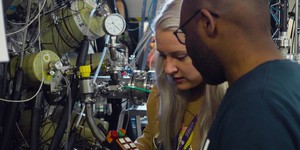Summary
Areas of Science
Difficulty
Time Required
Average (6-10 days)
Prerequisites
None
Material Availability
Specialty items: Tube and pipe cutter wheel, or hack saw.
Cost
Low ($20 - $50)
Safety
Adult supervision required to cut the copper pipe.
*Note:
For this science project you will need to develop your own experimental procedure. Use the information in the summary tab as a starting place. If you would like to discuss your ideas or need help troubleshooting, use the Ask An Expert forum. Our Experts won't do the work for you, but they will make suggestions and offer guidance if you come to them with specific questions.
If you want a Project Idea with full instructions, please pick one without an asterisk (*) at the end of the title.
If you want a Project Idea with full instructions, please pick one without an asterisk (*) at the end of the title.
Abstract
Did you know that making a musical instrument is not just an art, but a science, too? You can discover just how scientific by building your own xylophone (or a set of chimes) from copper pipe. First you'll need to do some research about the math and physics involved in the sounds of a xylophone. For example, there are equations that describe the transverse (side-to-side) vibrations of a pipe. These vibrations create the sounds you hear. So, to get specific sounds, xylophone makers must apply these equations to calculate the correct length of pipe for a given note. Can you use these equations to build a xylophone with eight pipe lengths representing the C major scale (do, re, me, fa, so, la, ti, do)? How should the pipe lengths change if you want to build a xylophone that plays a different scale? For help on how to actually build the xylophone, and more information about the equations you'll need, read the article by David R. Lapp, listed in the Bibliography. You might just find that playing with equations is music to your ears!Bibliography
- Lapp, D.R. (2003, July). Building a copper pipe "xylophone." Physics Education. Retrieved March 5, 2014.
Ask an Expert
Do you have specific questions about your science project? Our team of volunteer scientists can help. Our Experts won't do the work for you, but they will make suggestions, offer guidance, and help you troubleshoot.
Careers
If you like this project, you might enjoy exploring these related careers:
Career Profile
Any time you hear music at a concert, a live speech, the police sirens in a TV show, or the six o'clock news you're hearing the work of a sound engineering technician. Sound engineering technicians operate machines and equipment to record, synchronize, mix, or reproduce music, voices, or sound effects in recording studios, sporting arenas, theater productions, or movie and video productions.
Read more
Career Profile
Physicists have a big goal in mind—to understand the nature of the entire universe and everything in it! To reach that goal, they observe and measure natural events seen on Earth and in the universe, and then develop theories, using mathematics, to explain why those phenomena occur. Physicists take on the challenge of explaining events that happen on the grandest scale imaginable to those that happen at the level of the smallest atomic particles. Their theories are then applied to…
Read more
Related Links
Cite This Page
General citation information is provided here. Be sure to check the formatting, including capitalization, for the method you are using and update your citation, as needed.MLA Style
Science Buddies Staff.
"Build Your Own Xylophone Out of Copper Pipe." Science Buddies,
20 Nov. 2020,
https://www.sciencebuddies.org/science-fair-projects/project-ideas/Music_p024/music/build-your-own-xylophone-out-of-copper-pipe.
Accessed 17 Apr. 2024.
APA Style
Science Buddies Staff.
(2020, November 20).
Build Your Own Xylophone Out of Copper Pipe.
Retrieved from
https://www.sciencebuddies.org/science-fair-projects/project-ideas/Music_p024/music/build-your-own-xylophone-out-of-copper-pipe
Last edit date: 2020-11-20
Explore Our Science Videos
Make a Self-Starting Siphon
DIY Mini Drone Part 3: Arduino Altitude Control
Make an Ion Wind Rotor








